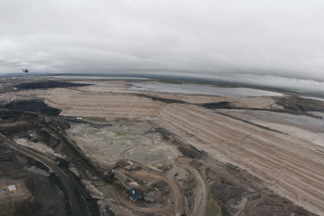 Geologists
generally assume that the Alberta, Canada, oil sand deposit formed when dinosaurs
prowled Earth during the late Cretaceous. But new isotopic measurements reveal
that these previous estimates may be off by tens of millions of years.
Geologists
generally assume that the Alberta, Canada, oil sand deposit formed when dinosaurs
prowled Earth during the late Cretaceous. But new isotopic measurements reveal
that these previous estimates may be off by tens of millions of years. The Western Canada Sedimentary Basin is a large source of recoverable oil, and researchers have recently redated the deposit to some 60 million years older than previously thought. Photo courtesy of Syncrude Canada Ltd.
About the size of Ireland, the Western Canada Sedimentary Basin is the largest oil sand deposit in the world. But the age and source of that oil has remained unknown. One idea has held that the oil formed and moved to fill the basin 60 million years ago during the Laramide orogeny — a series of mountain-building events that greatly affected the Rocky Mountains in western Canada. But according to David Selby and Robert Creaser in the May 27 Science, measurements of rhenium and osmium ratios in the oil date the deposit to about 112 million years old.
“The thing that is significant about this paper is timing,” says Larry Cathles, a chemical geologist at Cornell University in New York, who was not involved in the study. The formation of an oil field first requires an abundance of decayed organic material, which is compacted by sediment until it turns into a source rock, the pressure from which creates intense heat that converts the components to liquid oil at about 90 degrees Celsius (194 degrees Fahrenheit). The oil then buoyantly migrates uphill until it reaches an impermeable layer that traps it to pool into a reservoir. “It’s similar to rainwater collecting in ponds,” Cathles says. “Think of that inverted.”
According to Bruce Schaefer, a geoscientist at Monash University in Australia, attempts by other researchers to date the oil focused on determining the age of either the initial source rock or the current host rock. “However, these can differ by up to hundreds of millions of years from the actual time of migration,” Schaefer says. Researchers also tried sampling the oil directly and measuring isotopes, such as rubidium and strontium, without much success. “None of them have been able to investigate that critical moment when oil is actually extracted from a rock and migrates,” Schaefer says. “They generally preserve errors that are so large as to be meaningless.”
But Selby and Creaser say they knew that a phenomenon specific to a different isotopic system, rhenium-osmium, could significantly reduce the error in dating oil. Selby says that the exact mechanism has not been determined, but it is known that at the time of petroleum generation — when oil containing rhenium-osmium isotopes leaves the source rock — the isotope ratios are somehow reset. Without the isotopes, the age would apply not to the oil deposit but to the source rock itself, which, in the case of Alberta, is about 250 million years older. “There has to be some sort of resetting going on,” Selby says. “That’s the key thing.”
Taking advantage of that phenomenon, using isotopic analysis they were able to determine the time the oil began migrating. “This technique is exciting and holds a lot of promise,” Schaefer says.
The rhenium-osmium oil dating technique has the potential to date oil reservoirs all over the world, and could help geologists identify the rocks from which known oil deposits originated, Selby says. “It’s not going to let us find new oil,” he says, “but it will help us understand the basin in greater detail.”
Kathryn Hansen

